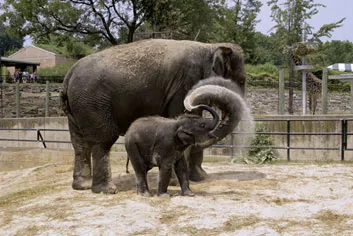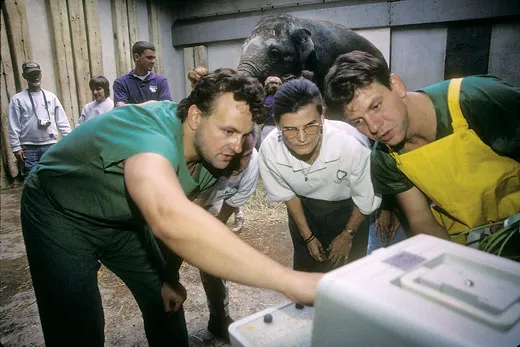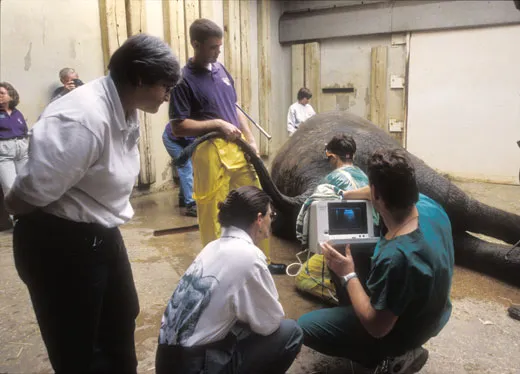Great Expectations
Elephant researchers believe they can boost captive-animal reproduction rates and reverse a potential population crash in zoos
A little before 5:30 one August morning two years ago, workers at the Oakland Zoo began calling colleagues at home to hurry in. For more than a month, staff and volunteers had held a round-the-clock vigil watching a pregnant 24-year-old African elephant on a video monitor, and now they saw the time had come. The elephant, Lisa, heaved to her feet and released an enormous amount of water onto the straw-covered floor. Her 22-month pregnancy was over.
An elephant birth in captivity is unusual and highly anticipated: of 17 African elephants born in North America since 1995, only 6 survive. (Only 24 of 38 Asian elephants born during the same period survive.) So when the 327-pound baby arrived three and a half hours after Lisa’s water broke, Oakland Zoo workers were ready. They quickly checked the calf ’s heartbeat, took a blood sample and swabbed fluids from his dark gray skin. From his first moments, the calf charmed the keepers, waving his tiny trunk with animation. The skin around his eyes was tinged a light pink, making him look as though he had stayed up too late. In his curiosity to explore his surroundings, the calf strained against the two yellow fabric strips slung under his belly to help him stand. “Lisa touched and smelled the calf and watched to see what would happen,” recalls the Oakland Zoo’s elephant manager, Colleen Kinzley. “She was very excited.”
The staff named the baby Dohani, Swahili for “smoke,” in honor of his father, Smokey, who lived at the Oakland Zoo until he died of chronic wasting disease earlier that year. “From the very first moment that Lisa had the calf with her, we could not have hoped for it to have gone better,” reports Kinzley. Lisa appeared to adapt to motherhood, following her baby everywhere, often touching him. Then, on the 11th day, keepers found Dohani dead on the floor of the elephant room with a puncture wound to the chest. Lisa stood over his body for hours, refusing to move.
This tragedy highlights the challenge of breeding elephants in captivity. Was Dohani’s loss just an accident, perhaps the result of an inexperienced 9,000-pound mother misjudging her strength while nudging her calf? Or had something spooked Lisa and caused her to impale Dohani? Could the zookeepers have prevented Dohani’s death, perhaps by teaching Lisa a broader array of parenting skills?
Such questions have broad importance because of predictions that North America’s captive elephant population simply can’t sustain itself. If current trends continue, in 50 years there will be only four female African elephants young enough to breed at zoos and parks, according to a 2000 study by Robert Wiese, director of animal collections at Texas’ Fort Worth Zoo. (About 225 African and 284 Asian elephants now reside in North America.) “The Wiese study woke up the elephant community to how much work and how little time we have,” says Janine Brown, a reproductive physiologist for the Smithsonian’s National Zoological Park.
Historically, says Brown, zoo biologists went to Asia or Africa to replace lost animals. But dwindling wild populations and new legal restrictions on endangered animals have led zookeepers to explore captive breeding as an alternative. The first known captive-born Asian elephant to survive infancy in North America was Packy, who was delivered in 1962 at the Oregon Zoo. The continent’s first captive African birth came when a female named Little Diamond was born in 1978 at Knoxville Zoological Gardens. All told, only 129 Asian elephants and 38 African elephants have been born in North America since 1962. The infant mortality rate is above 30 percent. To make matters worse, a mystery disease killed at least 7 of the 34 Asian elephants born in North American zoos between 1983 and 1996. Among the dead was 16-month-old Kumari, who died in 1995 at the National Zoologica lPark in Washington, D.C. Through careful sleuthing, National Zoo pathologists Richard Montali and Laura Richman discovered that Kumari had died from a previously unknown form of the herpes virus. Richman, who now works for a private company, and Montali believe that one way Asian elephants pick up the disease is from contact in zoos with African elephants, which can carry the disease without ill effect. U.S. zoo-keepers have saved the lives of three sick animals by administering Famciclovir, an antiviral drug also used to fight herpes in humans.
Meanwhile, wild elephants have become even scarcer. In Africa, authorities estimate that the elephant population has dropped from 1.3 million in the 1970s to between 270,000 and 500,000 to-day. In Asia, elephant populations have dropped from an estimated 100,000 in 1900 to between 38,000 and 48,000 today. Among the threats to wild elephants are poachers, who kill the animals for their ivory tusks and meat; roads and railways that cross elephant migration routes; and farmland, which is replacing stamping grounds. In some places, farmers have killed elephants that have trampled crops and fences. “Elephants get killed every year,” says Steve Osofsky, senior policy adviser for wildlife health at the New York-based Wildlife Conservation Society.
North American zookeepers hope to breed elephants not only to curb the need for further imports but also to develop new reproductive techniques that can be applied to wild herds. But captive breeding is fraught with physical obstacles and philosophical quandaries. Zoos cannot easily replicate life in the wild, where females generally live in matriarchal groups of 8 to 12 members that are usually related. In contrast, captive females often end up in small groups of unrelated individuals. Some groups contain Asian and African species. In addition, many zoos are unable to accommodate a full-grown bull, which can weigh up to 16,000 pounds and can be aggressive toward other elephants and zookeepers.
For years, some zoos have facilitated elephant courtship by loading a female onto a truck, driving her to a breeding bull and hoping for the best. The hope was usually forlorn. Infertility is a problem. Females older than 30 who are conceiving for the first time have a high incidence of stillbirths, and about 15 percent of captive Asian females and 25 percent of captive Africans of calf-bearing age are known as flatliners, meaning their reproductive hormone cycle is inactive.
Artificial insemination, which has worked well on many other species, is a challenge with captive elephants. Designing a means of navigating an elephant’s eight-foot-long, curving reproductive tract and timing an elephant’s estrus are among the obstacles. (An elephant’s period of fertility—only two or three days out of every four-month estrus cycle—has been difficult to predict until recently.) In addition, facilities without a resident male must import bull sperm, which remains potent for only 24 to 48 hours. (Elephant sperm usually loses its viability when frozen, so establishing a sperm bank is not an option.) At the National Zoo, which doesn’t have a bull, veterinarians must obtain samples from several bulls at different locations across North America and must time inseminations precisely. “It’s like cooking a huge meal,” says Brown, adding, “It takes a lot of planning to make sure that all the different courses come out at the right time and it’s all hot when you go to serve it.”
In October 1995, the National Zoo attempted its first artificial insemination on an Asian elephant named Shanthi, using new technology designed by Berlin’s Institute for Zoo Biology and Wildlife Research. Along endoscope, which was equipped with fiber optics and contained a catheter that was guided by ultrasound, successfully delivered sperm. But Zoo scientists missed the elephant’s estrus by four days. In reviewing Shanthi’s case, however, Brown discovered a hormone that spikes three weeks before a female becomes fertile. This finding now allows researchers to pinpoint estrus with a simple blood test.
The first successful birth following artificial insemination took place in November 1999 at the Dickerson Park Zoo in Springfield, Missouri, when Moola, an Asian elephant, gave birth to a male named Haji. (He died from the herpes virus two and a half years later.) In 2001, Shanthi became the second artificially inseminated captive Asian elephant to deliver a calf. Despite the technical challenges and costs, ranging between $10,000 and $15,000 per event, artificial insemination offers the best way of increasing the birthrate in the short run, says Dennis Schmitt, an animal science professor at SouthwestMissouriStateUniversity, who, along with Brown, is one of the nation’s foremost experts on the procedure. “It’s not the answer, but a tool,” he says.
Dohani’s death, the way some experts see it, can be attributed to his mother’s experience—or lack of it. Lisa came to the Oakland Zoo in 1976 when she was about 6 months old, after being captured in South Africa. She never had the chance to learn how to be a mother. In the wild, a female elephant grows up with her mother and aunts, watching as they give birth roughly every four to five years and observing how they care for their young. In fact, females in the wild assist one another during birth, and later engage in a form of collective baby-sitting called “allomothering,” in which they protect, play with and sometimes even nurse the others’ offspring. Wild elephants have even been observed crowding a reluctant mother, forcing her to be still so her calf can nurse, or disciplining mothers that are too rough with a baby.
“None of that background and learning happens when you take a young female who is maybe 6 months of age out of the wild,” says Joel Parrott, the Oakland Zoo’s executive director. Among captive elephants, reluctant mothers are not uncommon. Deborah Olson, director of conservation and science at the Indianapolis Zoo, recalls the case of an aggressive new mother that tried repeatedly to kill her newborn. “It took us three weeks to convince her that this baby was a wonderful thing,” Olson says. Researchers don’t know if such maternal aggression occurs in the wild.
At the Oakland Zoo, Lisa had been so aggressive toward her first live calf, Kijana, born in 1995, that zoo staff raised the baby by hand. In general, calves separated from their mothers at birth don’t survive. Kijana proved no exception, dying at 11 months of herpes. So when Lisa became pregnant with Dohani, staff members attempted to prepare her for motherhood by creating an elephant baby doll, which they stuffed and placed near Lisa so she would get used to sharing her space with a smaller creature; they trained her to lift a foreleg on cue so a calf could reach her nipples. Even so, Kinzley recalls that it took Lisa several days to learn how to help Dohani stand, which Lisa did with a push of her foot and trunk.
Dohani’s death also cuts to the core of a current debate among zookeepers about how best to work with elephants. The more traditional elephant management method, called free contact, comes from ancient Indian customs in which handlers share the same space and freely touch the animals using a hooked stick, or ankus, to direct them.
Anew method, known as protected contact, favors rewards over force. Human contact is limited, and a physical barrier—such as fixed metal bars—remains between animal and handler. The Oakland Zoo first adopted the approach in 1991 after Dohani’s father, Smokey, killed a handler. It was the nation’s first zoo to practice protected contact with all of its elephants. (About half of U.S. zoos now use the method to manage some elephants.)
Dohani’s death hasn’t done much to reassure critics of protected contact. Could more active involvement have saved Lisa from killing Dohani? “My guess is that had we even been standing right there in the stall with her, whatever happened, happened so fast that we probably would not have even been able to stop it,” says Kinzley. And Parrott points out that if the goal of captive breeding is to allow elephants a more normal life, there has to be a limit to human intervention. “At some point,” he says, “nature has to be allowed to be nature.”
The difficulties of captive breeding have led some to conclude that it is a waste of precious resources. Carol Buckley, cofounder of the Elephant Sanctuary in Hohenwald, Tennessee, says money and effort should be spent preserving wild elephant habitat rather than creating new babies behind bars. “At this point, it’s irresponsible for us to be breeding elephants in captivity,” she says. “It is impossible for zoos in an urban setting to provide a life for captive elephants that reflects their natural life.”
The American Zoo and Aquarium Association, which accredits and sets standards for the facilities, banned the keeping of solitary elephants in 2001. Some zoo professionals hope that the ban will increase the captive elephant population, enabling more animals to stay in natal groups and perhaps breed more readily on their own. “I see subsequent generations of captive elephants as being good mothers, and our not having to play such a large role,” says Olson.
At the Oakland Zoo, staffers plan to acquire another bull elephant to breed with Lisa. Should she give birth again, says Parrott, the zoo will maintain a round-the-clock watch for a month after the delivery.
It will take the better part of a decade, says Wiese, for researchers to know if breeding programs are helping to stave off North America’s elephant population crisis. In the meantime, there’s debate over whether zoos should import more females to bolster the breeding ranks. But there is little time to argue. “We don’t want to wait until there are ten elephants left in captivity and then investigate how to bring the population back,” says Olson.
“The goal is not to get as many elephants in captivity as we possibly can,” says Kinzley. “The goal is to use these as true ambassadors of the species, and have their lives be as full as they can be.” One afternoon while watching Lisa play under a sprinkler at the Oakland Zoo, Kinzley recalled how happy Lisa seemed after Dohani was born. After a setback like Dohani’s death, she said, zoo professionals should keep trying—for the elephants’ sake. “I think it would be selfish on our part to give up.”


